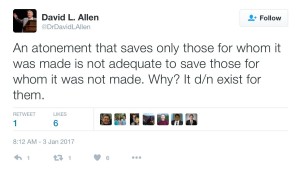Dr. John MacArthur:
Category Archives: Atonement
The Design and Scope of the Atonement
This post was originally published in Tabletalk magazine. (Original source it seems almost suicidal, like facing the open floodgates riding a raft made of balsa wood, to appeal to a seventeenth-century theologian to address a pressing theological issue. Nothing evokes more snorts from the snouts of anti-rational zealots than appeals to sages from the era of Protestant Scholasticism.
“Scholasticism” is the pejorative term applied by so-called “Neo-Orthodox” (better spelled without the “e” in Neo), or “progressive” Reformed thinkers who embrace the “Spirit” of the Reformation while eschewing its “letter” to the seventeenth-century Reformed thinkers who codified the insights of their sixteenth-century magisterial forebears. To the scoffers of this present age, Protestant Scholasticism is seen as a reification or calcification of the dynamic and liquid forms of earlier Reformed insight. It is viewed as a deformation from the lively, sanguine rediscovery of biblical thought to a deadly capitulation to the “Age of Reason,” whereby the vibrant truths of redemption were reduced to logical propositions and encrusted in dry theological tomes and arid creedal formulations such as the Westminster Confession of Faith.
The besetting sin of men like Francis Turretin and John Owen was their penchant for precision and clarity in doctrinal statements. As J. I. Packer observed in his introduction of John Owen’s classic work, The Death of Death in the Death of Christ:
“Those who see no need for doctrinal exactness and have no time for theological debates which show up divisions between so-called Evangelicals may well regret its reappearance … . Owen’s work is a constructive broad-based biblical analysis of the heart of the gospel, and must be taken seriously as such … . Nobody has the right to dismiss the doctrine of the limitedness of the atonement as a monstrosity of Calvinistic logic until he has refuted Owen’s proof that it is part of the uniform biblical presentation of redemption, clearly taught in plain text after plain text.”
The “monster” created by Calvinistic logic to which Packer refers is the doctrine of limited atonement. The so-called “Five points of Calvinism” (growing out of a dispute with Remonstrants (Arminians) in Holland in the early seventeenth century) have been popularized by the acrostic T-U-L-I-P, spelling out the finest flower in God’s garden:
T — Total Depravity
U — Unconditional Election
L — Limited Atonement
I — Irresistible Grace
P — Perseverance of the Saints.
Many who embrace a view of God’s sovereign grace in election are willing to embrace the Tulip if one of its five petals is lopped off. Those calling themselves “four-point Calvinists” desire to knock the “L” out of Tulip.
On the surface, it seems that of the “five points” of Tulip, the doctrine of limited atonement presents the most difficulties. Does not the Bible teach over and over that Jesus died for the whole world? Is not the scope of the atonement worldwide? The most basic affirmation the Evangelical recites is John 3:16: “For God so loved the world … .”
On the other hand, it seems to me that the easiest of the five points to defend is limited atonement. But this facility must get under the surface to be manifested. The deepest penetration under that surface is the one provided by Owen in The Death of Death in the Death of Christ.
First, we ask if the atonement of Christ was a real atonement? Did Jesus really, or only potentially, satisfy the demands of God’s justice? If indeed Christ provided a propitiation and expiation for all human beings and for all their sins, then, clearly, all persons would be saved. Universal atonement, if it is actual, and not merely potential, means universal salvation. Continue reading
The Atonement: The Strongest Refutation of Rome’s Eucharistic Errors
God’s Intention in the Atonement
Let’s think about Dr. Allen’s claim here: there is an obvious presupposition that needs to be exposed and challenged. First, not those who are not His sheep. The once-for-all (temporal, not distributive use) sacrifice perfects those for whom it is made. The Father gives a specific people to the Son, the Son’s death brings about the salvation of each and every one of them, without fail (John 6:39). So there is harmony and consistency between the intention and will of the Father in the salvation of the elect, and the work of the Son in being personally united to the elect so that His death is their death, His resurrection their resurrection. Of course, if such a harmony exists, there is no room for the centerpiece of the synergistic universe: the autonomous will of the creature, man. So this consistency, this harmony, must be denied.
Next, note the assertion “is not adequate to save those for whom it was not made.” See the poorly hidden assumption? Why would the atonement have an intention other than that which is consistent with the actions of each of the members of the Godhead in their work of redemption? Why would the atonement have a different scope and purpose than that redemptive will of the Father? (Which is why synergists must assert a universal *redemptive* will of the Father and deny the specificity of the elect). In other words, why would the Father make personal, effective provision through union with the Son for those who will remain justly under His wrath? The assumption here is that there is some kind of justice issue involved *in the extension of grace* and that if the Father does not make *equal salvific provision* for each and every person, He is unjust. So make sure to note what this means: grace cannot be free, cannot be specific, cannot actually save—this is the watchword of the synergist, whether Roman or non. 
Allen is playing on the discussion of term “adequacy” in reference to the atonement, confusing, as almost all synergists and universal atonement advocates do, the fact that there is no inherent limitation upon the *efficacy* of the atonement with the reality that the atonement is purposeful and harmonious with the election of the Father and the application of the Spirit (harmonious action of the Triune God). The idea is to place in the mind of the reader the false suggestion that by making the atonement consistent with the decree of election and the application by the Spirit we are introducing a fundamental *flaw* or *weakness* or *limitation* in the atonement’s power, when in reality, just the opposite is the case. Once we realize what the atonement is (a true propitiatory sacrifice) and once we realize how the Son is doing the will of the Father in the salvation of the elect, we see not only the atonement’s great power and perfection, we also see the grave dangers that flow necessarily from the synergistic viewpoint that renders the atonement potential, impersonal, and theoretical.
Atonement
having first considered His person. The work is divided, as we have seen, according to the Scriptures themselves—Christ is Prophet, Priest and King. We have considered the teaching concerning Christ as Prophet and we are now considering His work as Priest. We have seen that He satisfies the desiderata which were laid down so clearly in Hebrews 5:1–5; He fulfils all those demands. And we saw that the two main functions of the Priest are to present offerings and sacrifices and to make intercession. I ended that lecture by saying that He has an offering to offer and a sacrifice to present that God has accepted. This brings us inevitably to the consideration of what it is our Lord does offer, and did offer to God, as our great High Priest. And at once we come face to face with the doctrine of the atonement. This concerns primarily, but not only, as I shall be at pains to emphasise, the death of the Lord Jesus Christ, and therefore our main subject now will be a consideration of the biblical teaching with regard to that.
Now the great question is: What exactly did happen when our Lord died upon the cross? Obviously this is a most vital question, indeed, the most vital question we can ever face together. It would be vital even if we were to look at these things merely from the prominence that is given to this truth in the New Testament itself. It is an actual fact that the death of our Lord upon the cross is mentioned directly
175 times in the New Testament and indirectly many more times. That in itself is staggering and arresting, and it shows the importance which is given to it in the New Testament Scriptures.
Or look at it like this: take the four Gospels; we realise that they are but four portraits of our Lord; they do not tell us everything about Him. John, you remember, ended His Gospel by saying, ‘And there are also many other things which Jesus did, the which, if they should be written every one, I suppose that even the world itself could not contain the books that should be written’ (John 21:25). But these are written; they are samples, if you like, they are books, they are portraits. And, of course, they are short. Each one of the Gospels is a comparatively short book and yet the striking thing is that in each of them practically one third of the space is devoted to the death of our Lord. It is exactly one third of Matthew; it is nearly one quarter of Luke; and in the case of Mark and John it is over one third.
So we can say that on average, of the space that is given to the coming of the Son of God into this world and all that He did and said, one third is devoted to His death and the events immediately leading up to it. So obviously the implication is that the Gospels are thus bringing us to see that while His incarnation and His life and teaching are of vital importance, the event that exceeds all others in importance is His death upon the cross. So there, again, is another reason why we should consider this very, very carefully and especially, let me remind you, when we bear in mind that the people who wrote those Gospels, under the guidance and leading of the Holy Spirit, knew very well that this very thing that they were so emphasising was, as Paul reminds the Corinthians, a ‘stumbling block’ to the Jews, and ‘foolishness’ to the Greeks (see 1 Cor. 1:23). Though they knew all that, they put it in the forefront.
Then when you look at the book of Acts, you will find that His death is given the same prominence. The apostle Paul’s method, wherever he went, was that he went into the synagogue and he did two things. He proved and established that ‘the Christ must needs have suffered’, and, second, he said that ‘This Jesus, whom I preach unto you, is Christ’ (Acts 17:3); and when you go on to the epistles the same thing is made abundantly clear. The apostle says, ‘I determined not to know any thing among you, save Jesus Christ, and him crucified’ (1 Cor. 2:2); and he goes on repeating it: ‘I delivered unto you first of all that which I also received, how that Christ died for our sins according to the scriptures …’ (1 Cor. 15:3); and there are other similar verses. Continue reading


